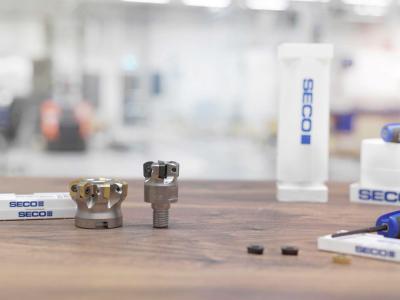
To eliminate long facemilling cycle times and ensure process security, Seco Tools has introduced new larger LP09 inserts for the company's HighFeed 2 cutter bodies. The new inserts are designed for high-feed milling operations including face, helical interpolation, slotting, side milling, pocketing and plunging, in challenging workpieces often found in the mold and die, aerospace, and oil and gas industries.
Extending the existing HighFeed 2 milling family, the new LP09 inserts combine higher insert corner strength with dual cutting edges, while the facemilling cutter bodies feature strong reinforced cores and more teeth per diameter for increased feed rates and faster material-removal rates. During high-feed milling, the optimized flutes of the cutter bodies evacuate chips quickly and efficiently.
The rectangular shape of the LP09 inserts along with the close-pitched cutter bodies help extend tool life beyond that of square inserts. Cutter-body pockets ensure consistent and precise insert positioning/seating when indexing, and high-strength screw clamping holds inserts securely in place.
Seco Tools LP09 positive inserts are available in a full range of chipbreakers, including MD15, M13 and ME08. HighFeed 2 cutter bodies range in size from 1.250 inches to 4.00 inches and from 25 mm to 100 mm.
Contact Details
Related Glossary Terms
- facemilling
facemilling
Form of milling that produces a flat surface generally at right angles to the rotating axis of a cutter having teeth or inserts both on its periphery and on its end face.
- feed
feed
Rate of change of position of the tool as a whole, relative to the workpiece while cutting.
- flutes
flutes
Grooves and spaces in the body of a tool that permit chip removal from, and cutting-fluid application to, the point of cut.
- gang cutting ( milling)
gang cutting ( milling)
Machining with several cutters mounted on a single arbor, generally for simultaneous cutting.
- interpolation
interpolation
Process of generating a sufficient number of positioning commands for the servomotors driving the machine tool so the path of the tool closely approximates the ideal path. See CNC, computer numerical control; NC, numerical control.
- milling
milling
Machining operation in which metal or other material is removed by applying power to a rotating cutter. In vertical milling, the cutting tool is mounted vertically on the spindle. In horizontal milling, the cutting tool is mounted horizontally, either directly on the spindle or on an arbor. Horizontal milling is further broken down into conventional milling, where the cutter rotates opposite the direction of feed, or “up” into the workpiece; and climb milling, where the cutter rotates in the direction of feed, or “down” into the workpiece. Milling operations include plane or surface milling, endmilling, facemilling, angle milling, form milling and profiling.
- slotting
slotting
Machining, normally milling, that creates slots, grooves and similar recesses in workpieces, including T-slots and dovetails.

